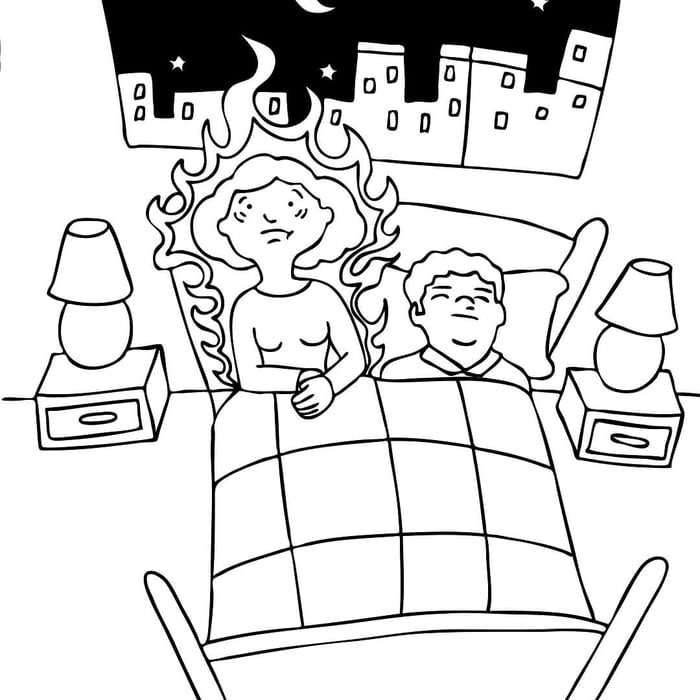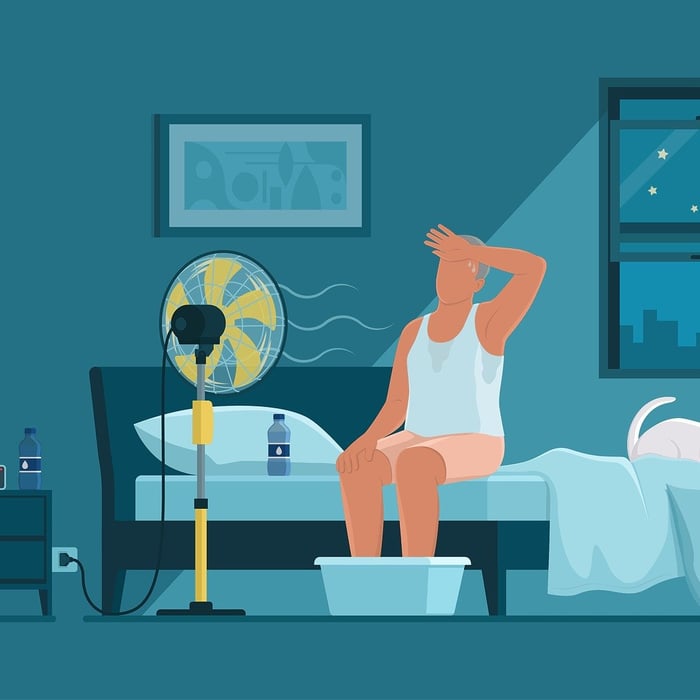Table of Contents
- Why “Cooling Bedding” Still Leaves You Hot and Sweaty
- The Real Reason Hot Sleepers Overheat (Hint: It’s Not Just Heat)
- How Each Material Actually Performs for Hot Sleepers
- Comparison: Wool vs Bamboo vs Down (and Down Alt) for Hot Sleepers
- What About Cooling Bedding Sets and Bed Cooling Toppers?
- The Real Winner for Hot Sleepers: Wool
- The Best Cooling Bedding Setup for Hot Sleepers
- FAQs on Wool Duvet Inserts, Comforters & Sustainable Bedding
Why “Cooling Bedding” Still Leaves You Hot and Sweaty
If you’re searching for cooling bedding, cooling bedding sets, or even a bed cooling topper, you’re probably dealing with the same nightly problem:
You go to bed comfortable…
…but wake up sweaty, hot, damp, and frustrated.
You’ve maybe tried:
Bamboo “cooling” sheets
Ultra-light down comforters
Down alternative duvets marketed as breathable
Even cooling bed toppers with gel or “ice” tech
And yet…
You’re still hot.
You’re still damp.
You’re still waking up uncomfortable.
Here’s the simple truth:
Most “cooling bedding” only deals with airflow at the surface, not the humidity trapped around your body.
Bamboo is breathable but traps humidity.
Down is warm and collapses under pressure.
Down alternative is usually polyester dressed up as “cooling.”
And none of them actually regulate temperature all night.
Only one natural material really does:
👉 Regenerative New Zealand Wool.
This guide breaks down wool vs bamboo vs down (and down alternative) so you can finally understand why hot sleepers keep overheating — and how wool solves the root problem.
Organic Wool Comforter | Made in New Zealand, Breathable All-Season Comfort
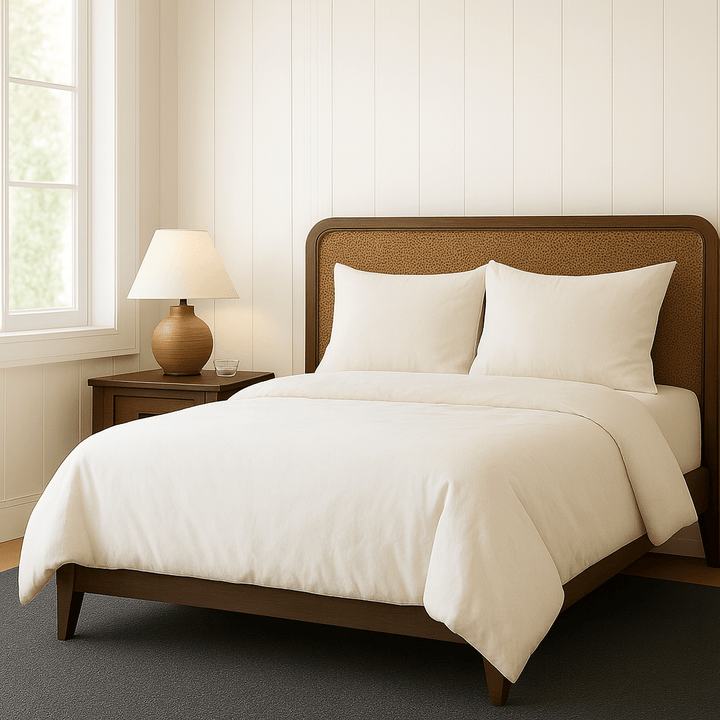
$342.00
$380.00
Sleep naturally better with our organic wool comforter Unlike down or synthetic comforters that trap heat, this lightweight wool design wicks away moisture and prevents overheating, so you stay cool, dry, and deeply relaxed. It’s comfort that feels effortless yet… Read more
The Real Reason Hot Sleepers Overheat (Hint: It’s Not Just Heat)
Most people think overheating happens because their comforter is “too warm” or their sheets aren’t “cooling enough.”
In reality, the real culprit is:
Trapped humidity in your microclimate.
Your microclimate = the small pocket of air between your body, your sheets, and your comforter.
When that space fills with humidity, this happens:
Airflow collapses – the air around you gets heavy and moist.
Your body can’t shed heat efficiently – so your core temperature rises.
Sweating starts – your bedding absorbs (or traps) moisture.
Your skin gets clammy – fabrics cling to your body.
You wake up hot and uncomfortable – often multiple times a night.
So the real question is not:
“Which material feels cool when I first touch it?”
It’s:
“Which material prevents humidity building up around my body all night long?”
That’s where wool pulls ahead — and bamboo, down, and down alternative fall behind.
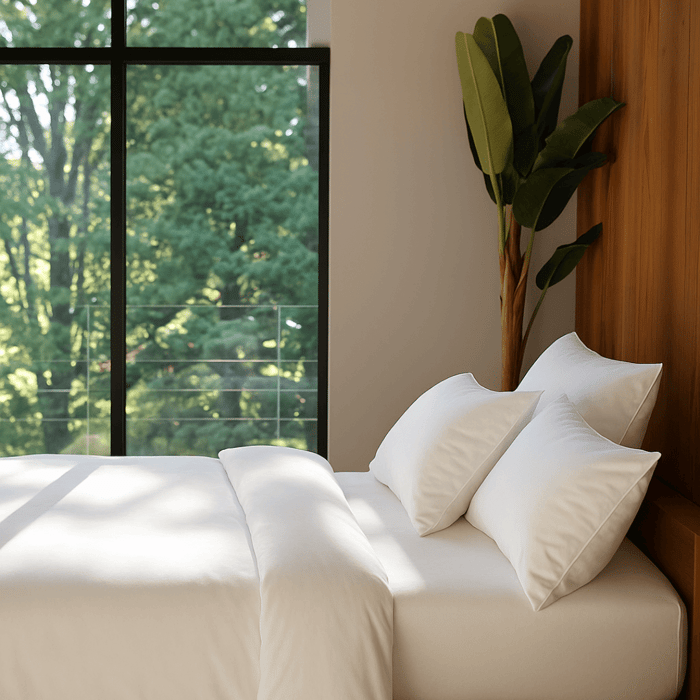 Cooling bedding performs best when it can release heat and moisture — natural fabrics like wool and cotton excel here.
Cooling bedding performs best when it can release heat and moisture — natural fabrics like wool and cotton excel here.How Each Material Actually Performs for Hot Sleepers
Let’s look at the three big “cooling” bedding categories people shop for:
Bamboo
Down
Down alternative (often sold as a “cooling” or “hypoallergenic” option)
Wool (regenerative Merino)
Bamboo: Marketed as Cooling, but Humidity Will Catch Up
People love bamboo because it’s often labeled:
“Cooling”
“Breathable”
“Moisture-wicking”
“Temperature-regulating”
But the reality is more complicated.
❌ Bamboo traps humidity
Most bamboo “cooling bedding” is actually bamboo rayon or viscose. In processing, the natural bamboo structure is chemically broken down and reformed into a smooth fiber.
End result:
You get a fabric that absorbs liquid moisture but does not move moisture vapor efficiently.
So when you sweat:
The fabric can feel damp and clingy
The humidity sticks around your body
Airflow drops, and you heat up again
❌ Feels cool at first, then warms up
Bamboo sheets and comforters often feel cool and silky for the first 20–30 minutes.
But as your body releases heat and moisture:
The fibers warm
Humidity accumulates
The cooling effect disappears
❌ Not truly temperature-regulating
Bamboo reacts after moisture shows up.
It doesn’t balance heat and humidity proactively.
Ideal for: people who run cold or live in mild climates.
Not ideal for: genuine hot sleepers, night sweats, or humidity swings.
 Cooling bedding doesn’t have to look technical — natural, airy fibers maintain comfort while fitting effortlessly into any bedroom style.
Cooling bedding doesn’t have to look technical — natural, airy fibers maintain comfort while fitting effortlessly into any bedroom style.Down: Warm, Cozy — and a Complete Disaster for Hot Sleepers
Down is:
Lightweight
Fluffy
Luxurious
It’s perfect for freezing cabins and alpine holidays — but it’s the last thing a hot sleeper should use.
❌ Down collapses under pressure
Down insulation works by trapping air between fluffy clusters.
When you lie on it:
Those clusters compress
Air pockets collapse
Airflow pathways shut down
That means you’re basically wrapped in a warm, insulated shell with nowhere for your body heat to go.
❌ Down traps heat
Down is designed to keep mountaineers alive in sub-zero climates, not to keep hot sleepers dry and comfortable.
It’s all about holding on to warmth, not balancing temperature.
❌ Down absorbs almost no moisture
Down doesn’t manage humidity well:
Your sweat sits on your skin
Moisture soaks into your sheets instead
You get a hot–damp–cold cycle that wrecks sleep
❌ Down creates humidity pockets
Warm air + moisture + no airflow = little steam pockets trapped around your body.
Ideal for: cold sleepers in truly cold environments.
Not ideal for: basically anyone who overheats or lives in a warm climate.
Down Alternative: Hypoallergenic… But Still a Heat Trap
A lot of “cooling comforters” and “cooling duvet inserts” are actually down alternative — usually a synthetic polyester fill spun to mimic down.
They sound healthier and lighter, but for hot sleepers they create a different problem.
❌ Usually polyester in disguise
Most down alternative:
Is made from synthetic fibers (polyester, microfiber)
Doesn’t absorb vapor at all
Holds onto heat instead of releasing it
So if you’re sleeping under a cooling bedding set that includes a down alternative comforter, you’re likely wrapped in plastic-based fibers.
❌ Low moisture management
Down alternative:
Can’t absorb vapor like wool
Doesn’t breathe well under pressure
Builds up humidity quickly in your microclimate
Result: that “lightweight” cooling comforter starts to feel stuffy and sweaty by 2 a.m.
Ideal for: people who need a cheaper or hypoallergenic alternative to down in colder rooms.
Not ideal for: hot sleepers, night sweats, or anyone looking for truly cooling bedding.
Wool: The Only Material That Actually Regulates Temperature
Now the good part.
Regenerative New Zealand Wool is the single best cooling bedding material for hot sleepers — even though it’s rarely marketed that way.
Here’s why it wins where bamboo, down, and down alternative lose.
Organic Wool Duvet Insert & Bedding Set | Sustainable & Regenerative | Made in New Zealand

$475.15
$559.00
Cooler Nights & Deeper Sleep — All Year Long If you’re searching for the perfect organic wool duvet insert and wool bedding set, this complete set includes both the duvet insert and cover. Our organic wool duvet set, designed using… Read more
1. Wool’s Natural Crimp = Continuous Airflow
Unlike bamboo or polyester, wool fibers are naturally:
Springy
Curled
Textured
This creates thousands of tiny air pockets that:
Circulate air around your body
Prevent heat from building up
Maintain airflow even when you’re lying under the comforter
Where down collapses and bamboo mats, wool keeps breathing.
2. Wool Absorbs Vapor Before You Sweat
This is the superpower that makes wool the king of cooling bedding.
Wool can absorb about 30–35% of its weight in moisture vapor — not liquid sweat.
That means:
It starts working before you feel damp
It pulls excess humidity away from your skin
It prevents your sheets from getting clammy
This breaks the overheating → sweating → damp → wake-up loop that ruins sleep for hot sleepers.
No other natural fiber does this so efficiently.
3. Wool Releases Humidity Back Into the Air
Wool doesn’t just hold onto moisture — it actively releases it back into the air as vapor.
This keeps your microclimate:
Dry
Breathable
Stable
Where bamboo and synthetics hang onto humidity, wool moves it away from your body.
4. Wool Regulates Temperature Dynamically
Wool doesn’t simply “cool you down.”
It regulates your temperature all night long.
When you warm up → wool releases heat.
When you cool down → wool provides gentle insulation.
That’s why a good wool comforter works:
In summer
In winter
In dry desert climates
In humid coastal climates
It’s naturally all-season — your body does less work, and your sleep goes deeper.
Comparison: Wool vs Bamboo vs Down (and Down Alt) for Hot Sleepers
You can use this as a mental checklist the next time you’re shopping for cooling bedding.
| Feature | Bamboo | Down | Down Alternative | Wool |
|---|---|---|---|---|
| Breathability | Good ✔ | Low ✖ | Medium — | Excellent ✔ |
| Moisture Handling | Medium — | Poor ✖ | Poor ✖ | Exceptional (vapor) ✔ |
| Airflow Under Pressure | Low — | None ✖ | Low — | High 🔥 |
| Humidity Control | Low — | None ✖ | Low — | Outstanding ✔ |
| Best for Night Sweats | Not ideal — | No ✖ | No ✖ | YES ✔ |
| Temperature Regulation | None ✖ | None ✖ | None ✖ | Dynamic ✔ |
Nothing else comes close.
What About Cooling Bedding Sets and Bed Cooling Toppers?
You’ll see a lot of products marketed as:
“cooling bedding sets”
“cooling bed toppers”
“cooling mattress pads”
Some use gels, phase-change materials, or synthetic “ice” fibers.
Do they help a bit? Sometimes — especially in very hot rooms.
But they mostly:
Address surface temperature, not humidity
Rely on synthetic materials that trap moisture
Provide a short-term cooling effect that fades overnight
A bed cooling topper can feel cooler at first touch, but if your comforter and sheets still trap humidity, you’ll wake up in the same hot, damp microclimate.
True cooling bedding isn’t about one tech layer.
It’s about how the entire sleep system manages heat and moisture.
That’s why wool stands out: it manages both at once.
The Real Winner for Hot Sleepers: Wool
If you run hot, sweat at night, or live in a warm climate, here’s the hierarchy:
🥇 1. Wool: the only true temperature regulator
Moisture vapor transfer
Continuous airflow
Real humidity control
All-season comfort
🥈 2. Bamboo: breathable but humidity-prone
Better than synthetics
Feels cool at first
Overheating returns as humidity builds
🥉 3. Down & Down Alternative: the worst for hot sleepers
Trap heat
Offer little to no humidity control
Create warm, sticky microclimates
Wool isn’t a “cooling gimmick.”
It’s a microclimate manager — naturally built for both heat and cold.
Sustainable & Regenerative Bedding Bundle | No More Night Sweats, Just Deeper Sleep
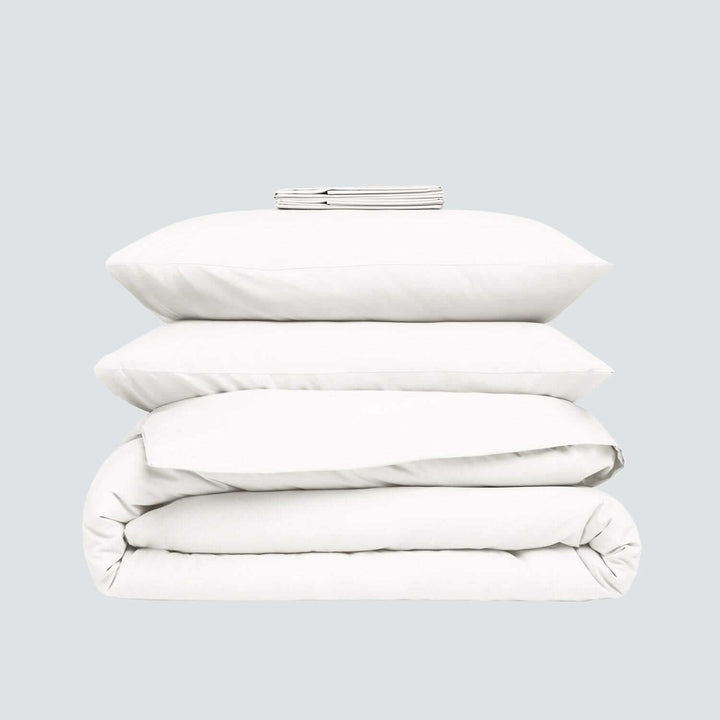
$598.40
$748.00
Cooler Nights & Deeper Sleep — Every Night Upgrade your rest with the only sustainable bundle designed with regenerative New Zealand wool and organic cotton for all-season comfort. This eco-friendly combo is made to naturally wick away heat and moisture,… Read more
The Best Cooling Bedding Setup for Hot Sleepers
If you really want to sleep cooler — without tech, gels, or synthetic tricks — build your sleep system around wool.
1. Wool Comforter
Your all-night temperature regulator and humidity manager.
2. Organic Cotton Sheets
Breathable, soft, non-toxic base layer that works with wool instead of against it.
3. Light Layering
Skip heavy blankets. Let the wool comforter do its job.
4. Balanced Room Humidity
Slightly cooler room + wool comforter = deep, restorative sleep.
Closing Thought
You don’t need more “cooling” labels.
You need bedding that actually works with your body, not against it.
If you’re tired of waking up hot and sweaty, it’s time to stop chasing cooling bedding tricks — and start sleeping in the one material that naturally regulates your temperature:
👉 Regenerative New Zealand Wool.
Cooler nights. Deeper sleep. Brighter mornings.
Explore Our Bedding For Hot Sleepers Collection
FAQs on Wool Duvet Inserts, Comforters & Sustainable Bedding
What is the difference between “cooling bedding” and temperature-regulating bedding?
Most cooling bedding is designed to feel cool at first touch (like bamboo sheets or gel-infused toppers). This is a surface-level effect and fades once body heat and humidity build.
Temperature-regulating bedding, like wool, actively manages airflow, humidity, and vapor throughout the night. Instead of reacting after you sweat, wool prevents overheating by keeping your microclimate dry and balanced.
Why do I still wake up sweaty even after buying cooling bedding?
Cooling bedding often fails because it doesn’t manage humidity. When moisture builds around your skin, your body can’t shed heat. This is the main reason your bedding feels warm, sticky, or damp even with breathable fabrics. Wool prevents this by absorbing vapor before it becomes sweat and releasing it away from the body.
Is bamboo actually cooling?
Bamboo feels cool initially because it is smooth and breathable. But once humidity rises, bamboo absorbs liquid moisture and holds onto it, creating a warm, clammy environment. Bamboo is cooling in feel, but not in performance. It doesn’t regulate temperature or manage vapor the way wool does.
Why is down such a bad choice for hot sleepers?
Down is an insulator designed to keep you warm. When you lie on it, airflow channels collapse, and heat gets trapped. Down also absorbs very little moisture, so humidity builds quickly. For hot sleepers or anyone with night sweats, down intensifies overheating instead of reducing it.
How does wool keep you cool at night if wool is known for warmth?
Wool works because of its temperature-regulating structure.
When you get warm, wool releases heat and moisture; when you cool off, it gently insulates. The key is wool’s ability to handle vapor, not liquid moisture. This keeps the microclimate around your body stable, dry, and breathable — the opposite of overheating.
Is wool bedding good for humid climates?
Yes — wool is exceptional in humid climates. While cotton or bamboo become damp, wool absorbs vapor and releases it back into the air, preventing humidity buildup around your skin. This helps reduce sweating and makes wool ideal for tropical or coastal regions.
Does wool work for people with night sweats or menopause?
Absolutely. Night sweats are caused primarily by humidity spikes trapped around the body. Wool prevents this by absorbing vapor instantly and keeping your bedding dry. This makes wool one of the most effective natural solutions for menopausal hot flashes and sweaty sleep.
Will a wool comforter be too warm in summer?
No. Unlike down, wool doesn’t trap heat. It regulates your temperature by circulating air and managing vapor. This means a high-quality wool comforter is naturally all-season — cool in summer, warm in winter, and balanced in between.
Are there benefits to pairing wool with organic cotton sheets?
Yes. Wool handles temperature and vapor, while organic cotton provides a breathable, soft, non-toxic base layer. Together, they create an optimized cooling bedding system that helps prevent overheating without chemicals, synthetics, or “cooling tech.”
What’s the best bedding setup for someone who sleeps hot every night?
For consistent overheating or sweaty sleep, the best setup is:
a wool comforter for temperature regulation and vapor control
organic cotton sheets for breathability
minimal layering
stable room humidity
This combination keeps the microclimate dry and prevents the heat/humidity loop that wakes you up sweaty.



